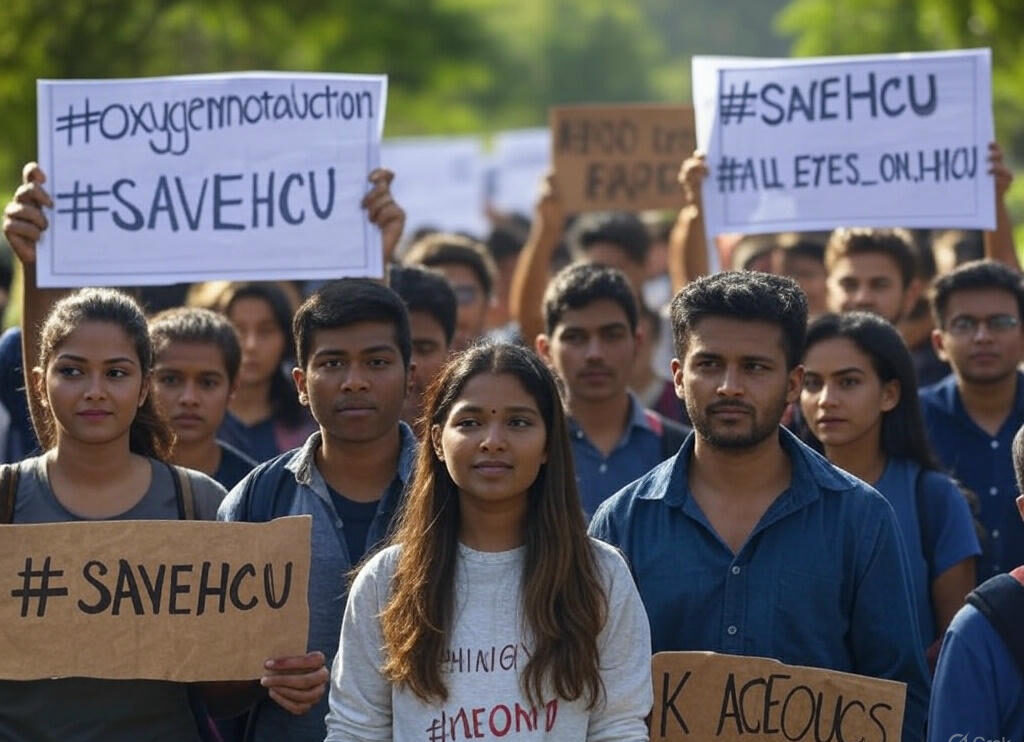The Current Dispute: Economics vs. Environment
The Hyderabad Central University (HCU) land controversy has intensified as the Telangana government moves forward with plans to transform 400 acres of land near the university into an IT park. The government, led by Chief Minister A. Revanth Reddy views this development as crucial for economic growth in the region, having already initiated the process of inviting tenders for a master plan and auctioning plots to private companies.
However, this plan has met fierce resistance from students, faculty, and environmental activists who argue that the land represents a significant biodiversity hotspot. According to the Vata Foundation, the area is home to 455 species, including monitor lizards, Indian rock pythons, peacocks, four-horned antelopes, and various birds. The contested area also encompasses four lakes and substantial forest cover that would be affected by development.
The controversy reached a flashpoint in late March 2025 when:
- Students burned an effigy of CM Revanth Reddy and launched the #oxygennotauction campaign
- Police arrested 52 students who attempted to block bulldozers (they were later released)
- Clashes erupted between protesters and police, leading to heightened security on campus
- The hashtag #SAVEHCU gained traction on social media, with over 4,700 users sharing related content
Legal Background
The dispute over ownership dates back several decades. HCU claims the 400 acres as part of its original 2,324-acre allocation from 1975. However, the Telangana High Court ruled in 2022 that no legal document proved this transfer, effectively confirming government ownership—a decision later upheld by the Supreme Court.
The legal timeline includes:
- A 2004 allocation to IMG Academies Bharat Pvt. Ltd. was canceled in 2006
- The government winning ownership rights in March 2023
- IMG’s Special Leave Petition being dismissed
- Current transfer of rights to the Telangana Industrial Infrastructure Corporation (TGIIC)
A Public Interest Litigation (PIL) filed by the Vata Foundation seeking “deemed forest” status for the land is scheduled for a hearing on April 7, 2025, adding another layer to the legal battle.
Political Dimensions
The controversy has taken on political dimensions, with opposition parties weighing in:
- The Bharat Rashtra Samithi (BRS) has accused the Congress government of destroying Hyderabad’s “green lungs” without proper environmental assessment
- BJP leaders, including Minister Bandi Sanjay Kumar, have demanded that the sale be halted
- The Congress party defends its position by referencing the 2004 land deal under a previous administration and dismissing some wildlife claims as exaggerated
Comparing with Similar Ecological Disputes
The HCU controversy reflects a pattern seen in other notable land disputes across India, particularly:
Hasdeo Forest (Chhattisgarh)
The Hasdeo Aranya forest, spanning 1,879.6 square kilometers, has been the site of prolonged protests against coal mining operations. Known as the “lungs of central India,” the forest is home to elephants, tigers, and numerous bird species. Government approval for mining has resulted in significant deforestation, with 30,000 trees already removed.
Tribal communities, primarily the Gonds, have led the resistance against displacement and environmental degradation. The “Save Hasdeo” movement parallels the HCU protests in its focus on biodiversity protection, though on a much larger scale and with a stronger emphasis on indigenous rights.
Singur (West Bengal)
The Singur dispute emerged when the state government acquired 997 acres in 2006 for a Tata Motors’ Nano car factory. Farmers’ protests against the acquisition eventually led to Tata Motors abandoning the project in 2008. The Supreme Court ordered the return of the land in 2016, though recent reports indicate that many farmers now wish to sell it back due to the deteriorated soil quality.
Like the HCU case, Singur involved community resistance to industrial development on disputed land, though the primary concern was agricultural livelihood rather than biodiversity.
Noida (Uttar Pradesh)
Noida continues to see recurring land acquisition disputes related to urban and industrial expansion. Recent developments include January 2025 investigations into alleged over-compensation in land deals and new acquisitions for the “New Noida” project near the airport.
While similar to HCU in its urban development context, the Noida disputes typically center on compensation and land rights rather than environmental preservation.
Core Themes and Implications
These land disputes highlight several consistent themes in India’s development landscape:
- The development versus conservation dilemma: All cases illustrate the tension between economic growth and environmental protection
- Community resistance: Whether from students, farmers, or tribal groups, affected communities have mobilized to protect their interests
- Legal complexities: Land ownership and rights in India often involve complicated historical claims and multiple legal proceedings
- Political dynamics: Land disputes frequently become platforms for political opposition and criticism of government policies
As the HCU controversy awaits its next legal hearing, it continues to exemplify India’s ongoing challenge of balancing economic ambitions with environmental stewardship and community rights.


